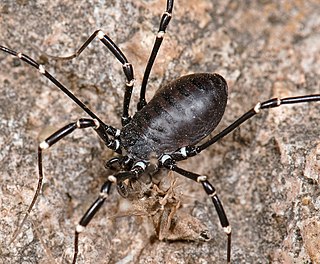| Odiellus spinosus | |
|---|---|
 | |
| Odiellus spinosus | |
| Scientific classification | |
| Kingdom: | |
| Phylum: | |
| Class: | |
| Order: | |
| Family: | |
| Genus: | |
| Species: | O. spinosus |
| Binomial name | |
| Odiellus spinosus | |
| Synonyms | |
| |
Odiellus spinosus is a species of harvestmen in the family Phalangiidae.
| Odiellus spinosus | |
|---|---|
 | |
| Odiellus spinosus | |
| Scientific classification | |
| Kingdom: | |
| Phylum: | |
| Class: | |
| Order: | |
| Family: | |
| Genus: | |
| Species: | O. spinosus |
| Binomial name | |
| Odiellus spinosus | |
| Synonyms | |
| |
Odiellus spinosus is a species of harvestmen in the family Phalangiidae.
Odiellus spinosus can reach a body length of 6.5–8 millimetres (0.26–0.31 in) in males, of 7–11 millimetres (0.28–0.43 in) in females. [2] This harvestmen shows three large, almost flat spines (hence the species name) in front of the eyes and a black-edged saddle on the back. Moreover the abdomen is distinctly flattened, with some rows of brown spots across each tergite. [2] [3]
Adults can be found from June and until December. [2]

The Opiliones are an order of arachnids, colloquially known as harvestmen, harvesters, harvest spiders, or daddy longlegs. As of July 2024, over 6,650 species of harvestmen have been discovered worldwide, although the total number of extant species may exceed 10,000. The order Opiliones includes five suborders: Cyphophthalmi, Eupnoi, Dyspnoi, Laniatores, and Tetrophthalmi, which were named in 2014.

The Pholcidae are a family of araneomorph spiders. The family contains more than 1,800 individual species of pholcids, including those commonly known as cellar spider, daddy long-legs spider, carpenter spider, daddy long-legger, vibrating spider, gyrating spider, long daddy, skull spider, and angel spider. The family, first described by Carl Ludwig Koch in 1850, is divided into 94 genera.

The cephalothorax, also called prosoma in some groups, is a tagma of various arthropods, comprising the head and the thorax fused together, as distinct from the abdomen behind. The word cephalothorax is derived from the Greek words for head and thorax. This fusion of the head and thorax is seen in chelicerates and crustaceans; in other groups, such as the Hexapoda, the head remains free of the thorax. In horseshoe crabs and many crustaceans, a hard shell called the carapace covers the cephalothorax.

The Phalangiidae are a family of harvestmen with about 380 known species. The best known is Phalangium opilio. Dicranopalpus ramosus is an invasive species in Europe.

Mitopus morio is a species of harvestman arachnid belonging to the family Phalangiidae.

Phalangium opilio is a species of harvestman belonging to the family Phalangiidae.

The Cladonychiidae are a small family of harvestman with about 33 described species, within the suborder Laniatores.

Opiliones are an order of arachnids and share many common characteristics with other arachnids. However, several differences separate harvestmen from other arachnid orders such as spiders. The bodies of opiliones are divided into two tagmata : the abdomen (opisthosoma) and the cephalothorax (prosoma). Unlike spiders, the juncture between the abdomen and cephalothorax is often poorly defined. Harvestmen have chelicerae, pedipalps and four pairs of legs. Harvestmen were traditionally thought to have two eyes, except in the case of eyeless species. Developmental genetic work has shown that living species retain up to six eyes, including one pair of rudimentary median eyes and one pair of rudimentary lateral eyes.

Codophila varia is a species of shield bug belonging to the subfamily Pentatominae in the family Pentatomidae.

Eurybunus is a genus of harvestmen in the family Globipedidae from the Western United States.

Astrobunus is a genus of harvestmen in the family Sclerosomatidae from Europe.

Odiellus is a genus of harvestmen in the family Phalangiidae.
Cristina is a genus of harvestmen in the family Phalangiidae.

Taracus is a genus of harvestman, or Opiliones, typically found living in limestone and lava caves in the United States. They grow to a size of 2.0–
Huitaca boyacaensis is a species of neotropical harvestmen in the family Neogoveidae, first described by Ligia Benavides and Gonzalo Giribet in 2013.

Isolachus is a genus of armoured harvestmen in the family Cladonychiidae. There is one described species in Isolachus, I. spinosus, found in Oregon and Washington.
Barolineocerus is a genus of leafhoppers in the family Cicadellidae.
Barolineocerus spinosus is a species of leafhopper native to the Colombian Amazon. The length is 4.5 millimetres (0.18 in). It is named for the unusual inner spine on the male subgenital plate. It is distinguished from other species in the genus by the subgenital plate. Only the male of the species has been described as of 2008.

Dasylobus argentatus is a species of harvestman in the family Phalangiidae.
Odius may refer to: